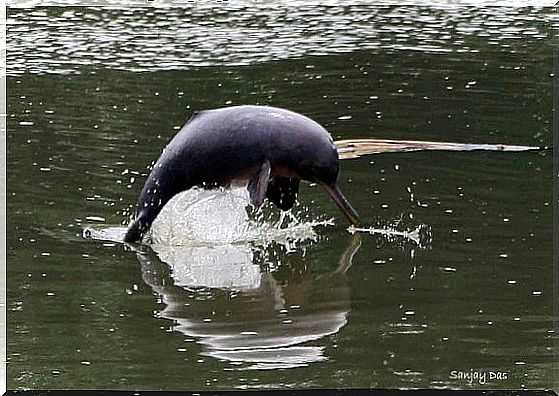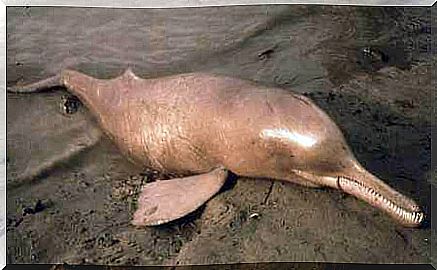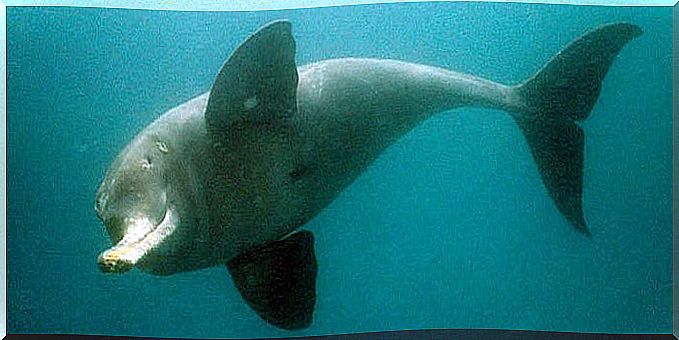Ganges Dolphin: Know All About This Species

The Ganges dolphin is another species of dolphin that is in danger of extinction. Due to the fact that it inhabits one of the most densely populated areas in the world, it has been a victim of indiscriminate fishing.
This situation has caused problems for marine ecosystems since the 1950s, which smothered the environment that serves them. However, the adaptability of this specimen to deal with the changes produced in its environment allowed it to survive with admirable distinction.
Other dolphins often move with overwhelming speed to capture their food. However, the Ganges dolphin is much slower than its cousins, but it has found other alternatives to feed.
This also outweighs the fact that he is totally blind, as he has developed skills to face the difficulties of nature.
Morphological characteristics of the Ganges dolphin
All river dolphins have similar typologies. They have a robust body, greater in weight and size than other species. Its skull is irregular, and a small crest protrudes from it. Also, your forehead is pronounced.
It has small eyes with absent ocular lenses, although in the muddy, muddy habitat in which it lives, its vision doesn’t do much good. They use echolocation to move around and detect their prey.
It also has a narrow, elongated snout, which contains a series of teeth that protrude even when closed. These teeth are not used for chewing, but rather for capturing their prey tightly and swallowing them.

One of the Ganges dolphin’s peculiarities is the separation of its cervical vertebrae, which allows it to flex its neck with greater inclination and dexterity; this gives it a special boost to move underwater.
The dorsal fins are triangular with a broad base, and the pectorals are longer and flatter. An adult individual can weigh 90 kilos and measure an average of about five meters.
Ganges dolphin behavior
One of its unique characteristics is its solitary lifestyle, so it is a real rarity to see a couple or large groups. It often flees in the face of human presence, an issue that has complicated the study of this species.
The Ganges dolphin also has a reserved and shy personality. They’re not dolphins you’ll see doing stunts or socializing with humans: they’re only seen swimming frantically when they detect any danger.
His way of swimming is different, with his head above the water, like a crocodile. It is often found inhabiting upstream waters – in meanders – to avoid channels and calm waters.
It was noted that nothing aside, although it was not possible to determine why, and it is estimated to be a territorial species as it has been seen chasing other dolphins. The maximum speed of your swim is 27 km/h.

Diet
The dolphin’s food includes birds, fish and turtles that roam the riverbanks. This variety of prey is due to their ability to adapt to their environment. When he locates his food, he holds it firmly between his jaws and swallows it whole.
Typically, the Ganges dolphin remains at the bottom of the river, where it encounters fish such as catfish and gobios, as well as shrimp and other invertebrates that eat without distinction.
breeding habits
This specimen can be seen year-round in mating, so it is believed that it does not have a definite season for it. He has only one pup at a time, which remains in maternal care for a year; when weaning takes place, the bonds between mother and child are broken.
It is estimated that the first copular encounter takes place between 6 and 10 years of age. Afterwards, they mate every two or three years. This wide variety, added to the late maturation of the Ganges dolphin and a life expectancy of approximately 25 years, directly influences the low population of the species, which is currently estimated at around 4,000 specimens.
Illegal hunting, destruction of the ecosystem where it lives and high water pollution are factors that increase the risk of extinction. Human intervention in places that belong to other species has been a problem for this dolphin and for other animals around the world.
Main Image Source | https://www.assamtimes.org








